FIAT PUNTO 2020 Owner handbook (in English)
Manufacturer: FIAT, Model Year: 2020, Model line: PUNTO, Model: FIAT PUNTO 2020Pages: 219, PDF Size: 9.82 MB
Page 101 of 219
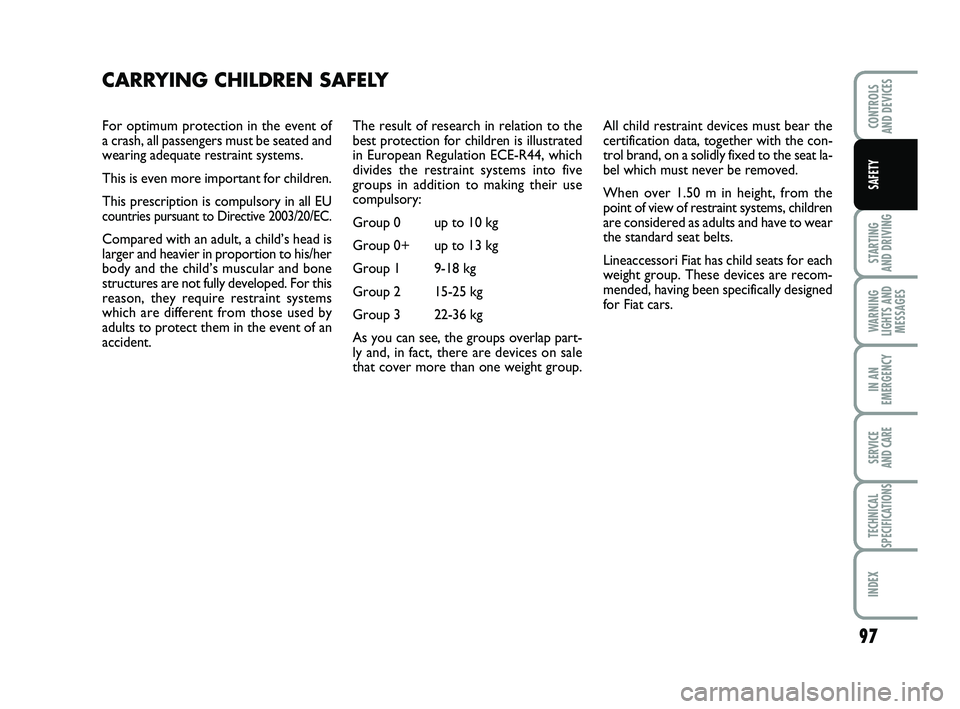
97
STARTING
AND DRIVING
WARNING
LIGHTS AND MESSAGES
IN AN
EMERGENCY
SERVICE
AND CARE
TECHNICAL
SPECIFICATIONS
INDEX
CONTROLS
AND DEVICES
SAFETY
For optimum protection in the event of
a crash, all passengers must be seated and
wearing adequate restraint systems.
This is even more important for children.
This prescription is compulsory in all EU
countries pursuant to Directive 2003/20/EC.
Compared with an adult, a child’s head is
larger and heavier in proportion to his/her
body and the child’s muscular and bone
structures are not fully developed. For this
reason, they require restraint systems
which are different from those used by
adults to protect them in the event of an
accident. The result of research in relation to the
best protection for children is illustrated
in European Regulation ECE-R44, which
divides the restraint systems into five
groups in addition to making their use
compulsory:
Group 0 up to 10 kg
Group 0+ up to 13 kg
Group 1 9-18 kg
Group 2 15-25 kg
Group 3 22-36 kg
As you can see, the groups overlap part-
ly and, in fact, there are devices on sale
that cover more than one weight group.
CARRYING CHILDREN SAFELY
All child restraint devices must bear the
certification data, together with the con-
trol brand, on a solidly fixed to the seat la-
bel which must never be removed.
When over 1.50 m in height, from the
point of view of restraint systems, children
are considered as adults and have to wear
the standard seat belts.
Lineaccessori Fiat has child seats for each
weight group. These devices are recom-
mended, having been specifically designed
for Fiat cars.
091-110 PUNTO POP 1ed EN 27/03/14 12:02 Pagina 97
Page 102 of 219
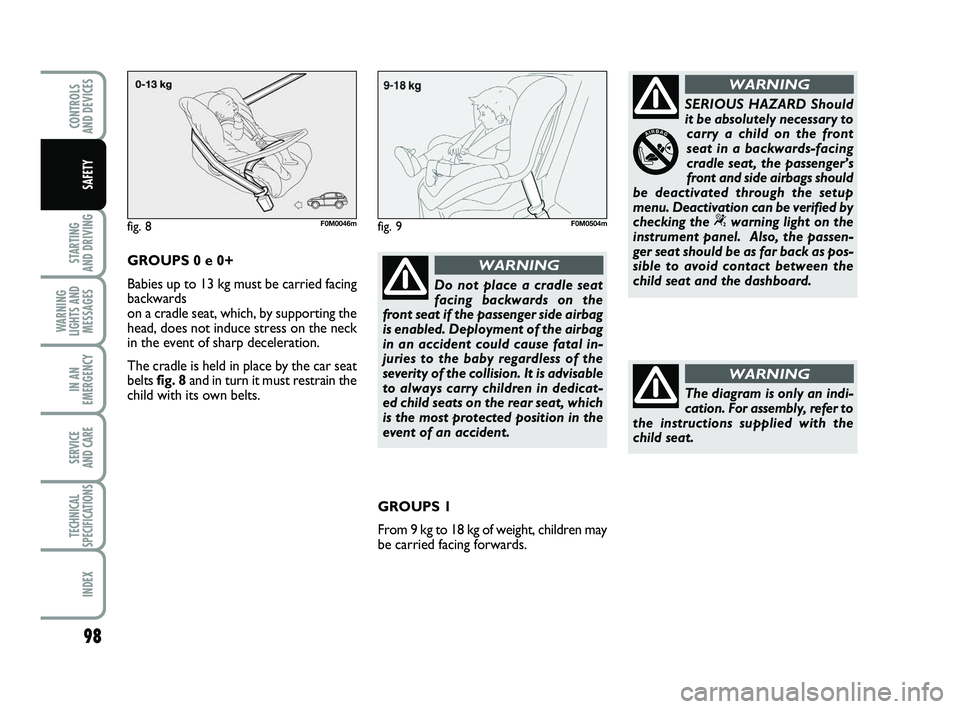
98
STARTING
AND DRIVING
WARNING
LIGHTS AND MESSAGES
IN AN
EMERGENCY
SERVICE
AND CARE
TECHNICAL
SPECIFICATIONS
INDEX
CONTROLS
AND DEVICES
SAFETY
Do not place a cradle seat
facing backwards on the
front seat if the passenger side airbag
is enabled. Deployment of the airbag
in an accident could cause fatal in-
juries to the baby regardless of the
severity of the collision. It is advisable
to always carry children in dedicat-
ed child seats on the rear seat, which
is the most protected position in the
event of an accident.
WARNING
SERIOUS HAZARD Should
it be absolutely necessary to carry a child on the front
seat in a backwards-facing
cradle seat, the passenger’s
front and side airbags should
be deactivated through the setup
menu. Deactivation can be verified by
checking the
“warning light on the
instrument panel. Also, the passen-
ger seat should be as far back as pos-
sible to avoid contact between the
child seat and the dashboard.
WARNING
fig. 8F0M0046mfig. 9F0M0504m
The diagram is only an indi-
cation. For assembly, refer to
the instructions supplied with the
child seat.
WARNING
GROUPS 0 e 0+
Babies up to 13 kg must be carried facing
backwards
on a cradle seat, which, by supporting the
head, does not induce stress on the neck
in the event of sharp deceleration.
The cradle is held in place by the car seat
belts fig. 8 and in turn it must restrain the
child with its own belts.
GROUPS 1
From 9 kg to 18 kg of weight, children may
be carried facing forwards.
091-110 PUNTO POP 1ed EN 27/03/14 12:02 Pagina 98
Page 103 of 219
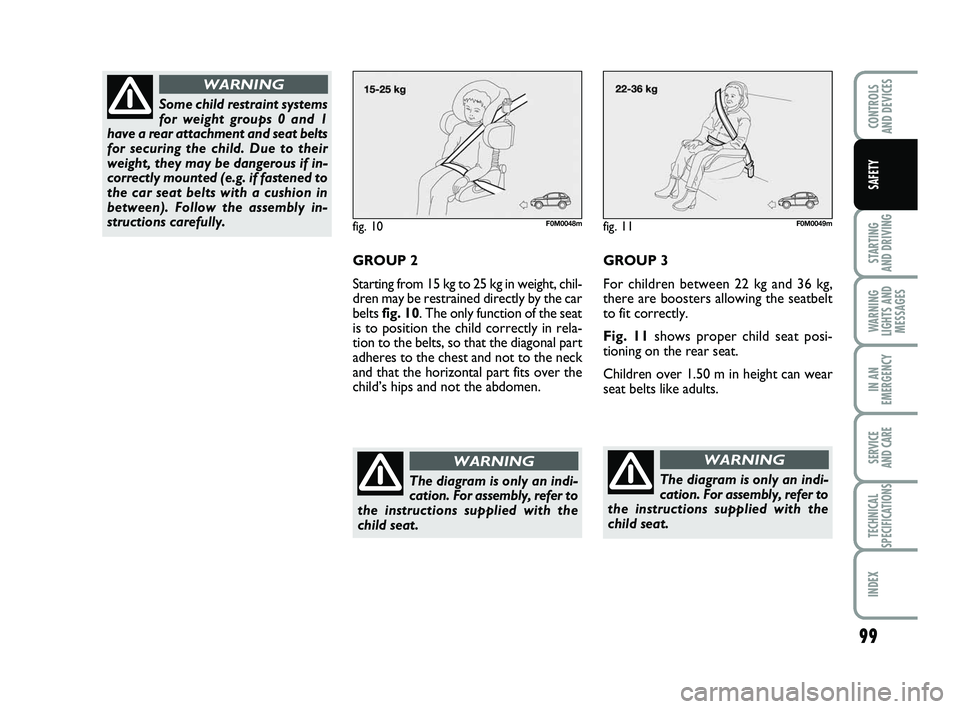
99
STARTING
AND DRIVING
WARNING
LIGHTS AND MESSAGES
IN AN
EMERGENCY
SERVICE
AND CARE
TECHNICAL
SPECIFICATIONS
INDEX
CONTROLS
AND DEVICES
SAFETY
fig. 10F0M0048m
GROUP 2
Starting from 15 kg to 25 kg in weight, chil-
dren may be restrained directly by the car
belts fig. 10. The only function of the seat
is to position the child correctly in rela-
tion to the belts, so that the diagonal part
adheres to the chest and not to the neck
and that the horizontal part fits over the
child’s hips and not the abdomen.
The diagram is only an indi-
cation. For assembly, refer to
the instructions supplied with the
child seat.
WARNING
Some child restraint systems
for weight groups 0 and 1
have a rear attachment and seat belts
for securing the child. Due to their
weight, they may be dangerous if in-
correctly mounted (e.g. if fastened to
the car seat belts with a cushion in
between). Follow the assembly in-
structions carefully.
WARNING
GROUP 3
For children between 22 kg and 36 kg,
there are boosters allowing the seatbelt
to fit correctly.
Fig. 11 shows proper child seat posi-
tioning on the rear seat.
Children over 1.50 m in height can wear
seat belts like adults.
fig. 11F0M0049m
The diagram is only an indi-
cation. For assembly, refer to
the instructions supplied with the
child seat.
WARNING
091-110 PUNTO POP 1ed EN 27/03/14 12:02 Pagina 99
Page 104 of 219
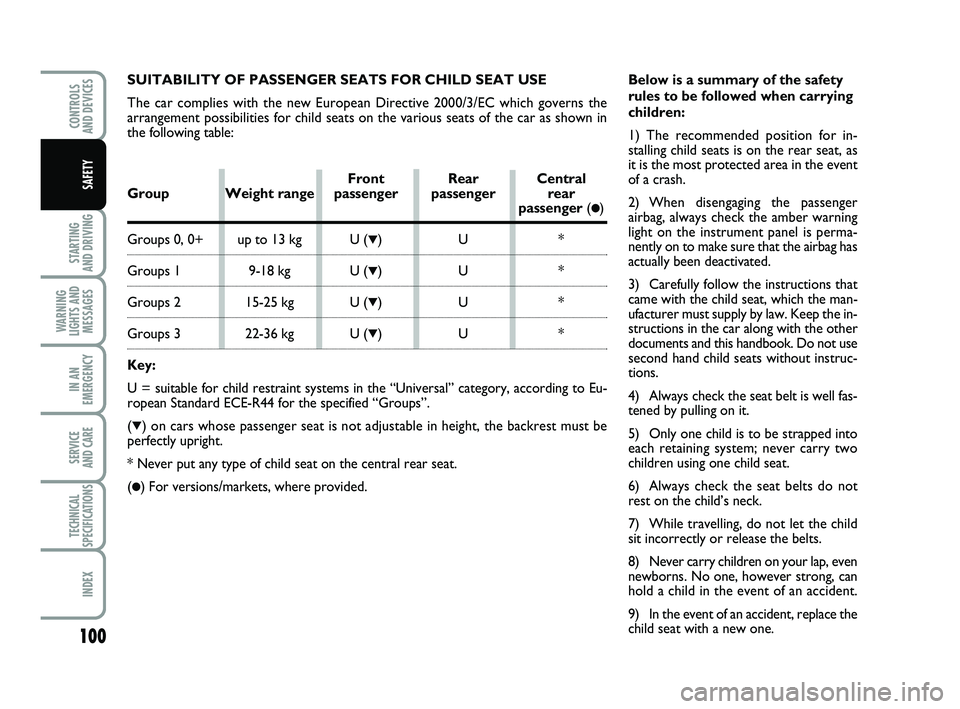
100
STARTING
AND DRIVING
WARNING
LIGHTS AND MESSAGES
IN AN
EMERGENCY
SERVICE
AND CARE
TECHNICAL
SPECIFICATIONS
INDEX
CONTROLS
AND DEVICES
SAFETY
SUITABILITY OF PASSENGER SEATS FOR CHILD SEAT USE
The car complies with the new European Directive 2000/3/EC which governs\
the
arrangement possibilities for child seats on the various seats of the ca\
r as shown in
the following table: Below is a summary of the safety
rules to be followed when carrying
children:
1) The recommended position for in-
stalling child seats is on the rear seat, as
it is the most protected area in the event
of a crash.
2) When disengaging the passenger
airbag, always check the amber warning
light on the instrument panel is perma-
nently on to make sure that the airbag has
actually been deactivated.
3) Carefully follow the instructions that
came with the child seat, which the man-
ufacturer must supply by law. Keep the in-
structions in the car along with the other
documents and this handbook. Do not use
second hand child seats without instruc-
tions.
4) Always check the seat belt is well fas-
tened by pulling on it.
5) Only one child is to be strapped into
each retaining system; never carry two
children using one child seat.
6) Always check the seat belts do not
rest on the child’s neck.
7) While travelling, do not let the child
sit incorrectly or release the belts.
8) Never carry children on your lap, even
newborns. No one, however strong, can
hold a child in the event of an accident.
9) In the event of an accident, replace the
child seat with a new one.
Front Rear Central
Group Weight range passenger passenger rear
passenger (●)
Groups 0, 0+ up to 13 kg U (▼)U *
Groups 1 9-18 kg U (▼)U *
Groups 2 15-25 kg U (▼)U *
Groups 3 22-36 kg U (▼)U *
Key:
U = suitable for child restraint systems in the “Universal” catego\
ry, according to Eu-
ropean Standard ECE-R44 for the specified “Groups”.
(
▼) on cars whose passenger seat is not adjustable in height, the backres\
t must be
perfectly upright.
* Never put any type of child seat on the central rear seat.
(
●) For versions/markets, where provided.
091-110 PUNTO POP 1ed EN 27/03/14 12:02 Pagina 100
Page 105 of 219
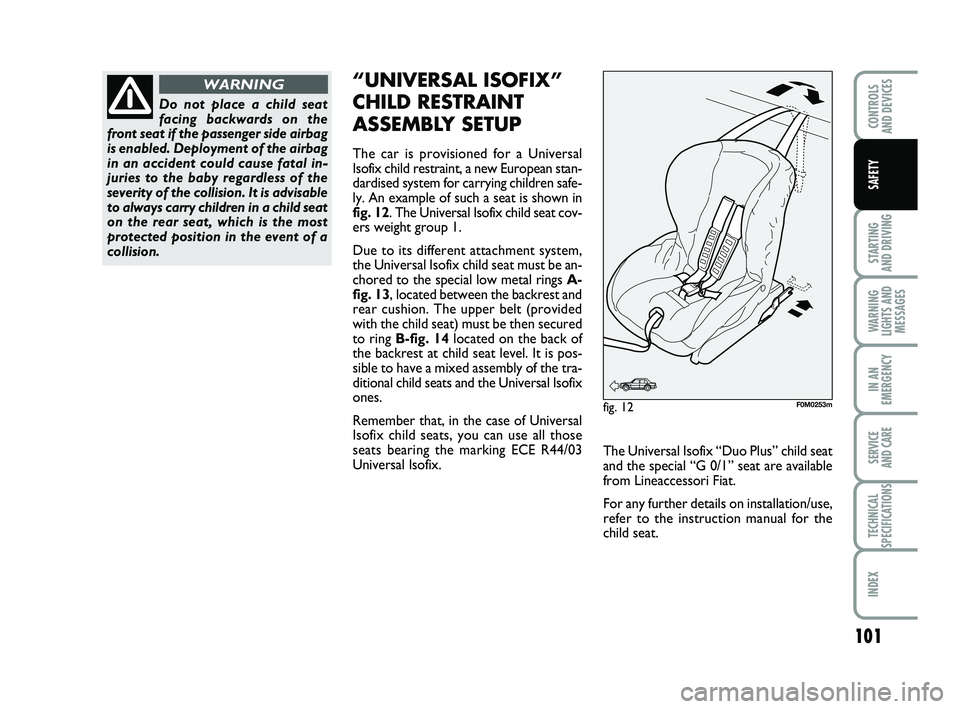
101
STARTING
AND DRIVING
WARNING
LIGHTS AND MESSAGES
IN AN
EMERGENCY
SERVICE
AND CARE
TECHNICAL
SPECIFICATIONS
INDEX
CONTROLS
AND DEVICES
SAFETY
Do not place a child seat
facing backwards on the
front seat if the passenger side airbag
is enabled. Deployment of the airbag
in an accident could cause fatal in-
juries to the baby regardless of the
severity of the collision. It is advisable
to always carry children in a child seat
on the rear seat, which is the most
protected position in the event of a
collision.
WARNING“UNIVERSAL ISOFIX”
CHILD RESTRAINT
ASSEMBLY SETUP
The car is provisioned for a Universal
Isofix child restraint, a new European stan-
dardised system for carrying children safe-
ly. An example of such a seat is shown in
fig. 12. The Universal Isofix child seat cov-
ers weight group 1.
Due to its different attachment system,
the Universal Isofix child seat must be an-
chored to the special low metal rings A-
fig. 13, located between the backrest and
rear cushion. The upper belt (provided
with the child seat) must be then secured
to ring B-fig. 14 located on the back of
the backrest at child seat level. It is pos-
sible to have a mixed assembly of the tra-
ditional child seats and the Universal Isofix
ones.
Remember that, in the case of Universal
Isofix child seats, you can use all those
seats bearing the marking ECE R44/03
Universal Isofix.
fig. 12F0M0253m
The Universal Isofix “Duo Plus” child seat
and the special “G 0/1” seat are available
from Lineaccessori Fiat.
For any further details on installation/use,
refer to the instruction manual for the
child seat.
091-110 PUNTO POP 1ed EN 27/03/14 12:02 Pagina 101
Page 106 of 219
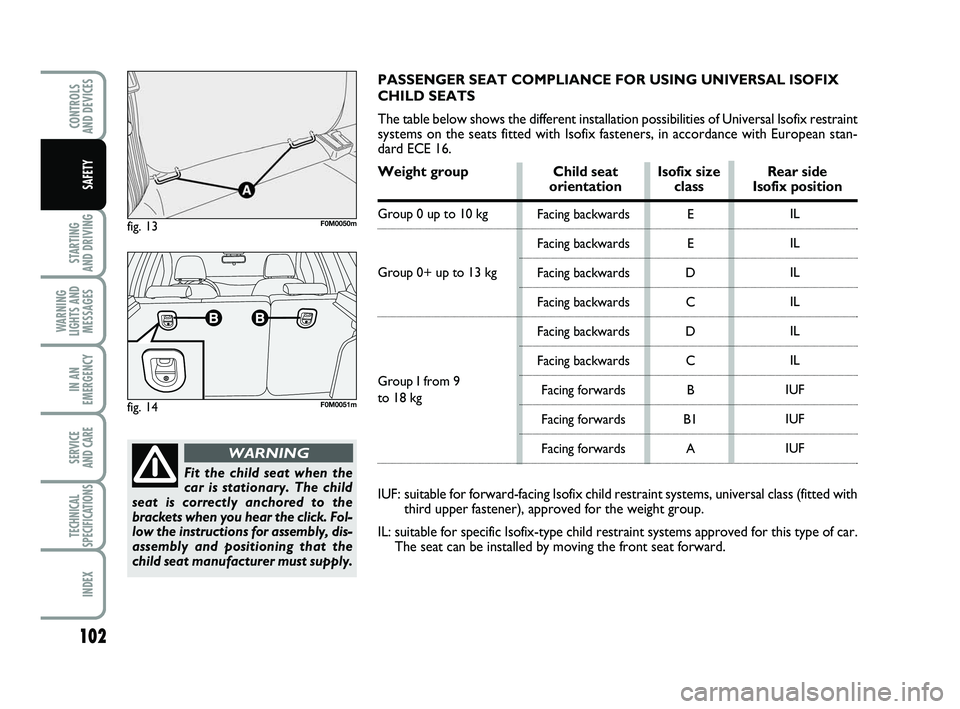
102
STARTING
AND DRIVING
WARNING
LIGHTS AND MESSAGES
IN AN
EMERGENCY
SERVICE
AND CARE
TECHNICAL
SPECIFICATIONS
INDEX
CONTROLS
AND DEVICES
SAFETY
fig. 13F0M0050m
fig. 14F0M0051m
Fit the child seat when the
car is stationary. The child
seat is correctly anchored to the
brackets when you hear the click. Fol-
low the instructions for assembly, dis-
assembly and positioning that the
child seat manufacturer must supply.
WARNING
E
E
D C
D C B
B1 A
PASSENGER SEAT COMPLIANCE FOR USING UNIVERSAL ISOFIX
CHILD SEATS
The table below shows the different installation possibilities of Univer\
sal Isofix restraint
systems on the seats fitted with Isofix fasteners, in accordance with Eu\
ropean stan-
dard ECE 16.
Weight group Child seat Isofix size Rear side
orientation class Isofix position
Group 0 up to 10 kg
Group 0+ up to 13 kg
Group I from 9
to 18 kg
IUF: suitable for forward-facing Isofix child restraint systems, universal cl\
ass (fitted with third upper fastener), approved for the weight group.
IL: suitable for specific Isofix-type child restraint systems approved for t\
his type of car. The seat can be installed by moving the front seat forward.
IL
IL
IL
IL
IL
IL
IUF
IUF
IUF
Facing backwards
Facing backwards
Facing backwards
Facing backwards
Facing backwards
Facing backwards
Facing forwards
Facing forwards
Facing forwards
091-110 PUNTO POP 1ed EN 27/03/14 12:02 Pagina 102
Page 107 of 219
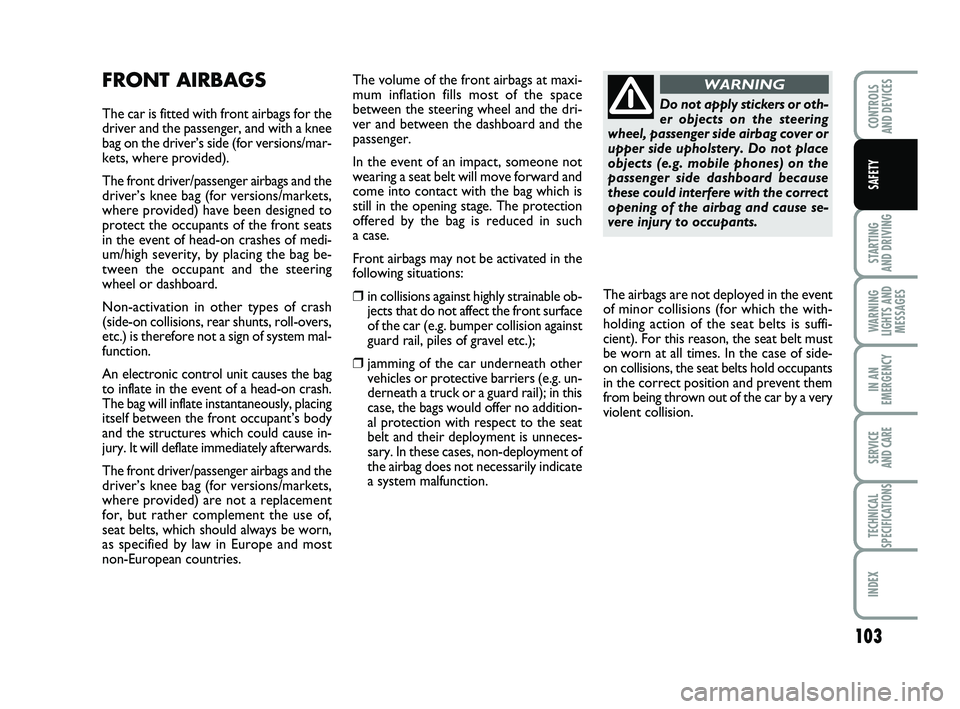
103
STARTING
AND DRIVING
WARNING
LIGHTS AND MESSAGES
IN AN
EMERGENCY
SERVICE
AND CARE
TECHNICAL
SPECIFICATIONS
INDEX
CONTROLS
AND DEVICES
SAFETY
FRONT AIRBAGS
The car is fitted with front airbags for the
driver and the passenger, and with a knee
bag on the driver’s side (for versions/mar -
kets, where provided).
The front driver/passenger airbags and the
driver’s knee bag (for versions/markets,
where provided) have been designed to
protect the occupants of the front seats
in the event of head-on crashes of medi-
um/high severity, by placing the bag be-
tween the occupant and the steering
wheel or dashboard.
Non-activation in other types of crash
(side-on collisions, rear shunts, roll-overs,
etc.) is therefore not a sign of system mal-
function.
An electronic control unit causes the bag
to inflate in the event of a head-on crash.
The bag will inflate instantaneously, placing
itself between the front occupant’s body
and the structures which could cause in-
jury. It will deflate immediately afterwards.
The front driver/passenger airbags and the
driver’s knee bag (for versions/markets,
where provided) are not a replacement
for, but rather complement the use of,
seat belts, which should always be worn,
as specified by law in Europe and most
non-European countries. The volume of the front airbags at maxi-
mum inflation fills most of the space
between the steering wheel and the dri-
ver and between the dashboard and the
passenger.
In the event of an impact, someone not
wearing a seat belt will move forward and
come into contact with the bag which is
still in the opening stage. The protection
offered by the bag is reduced in such
a case.
Front airbags may not be activated in the
following situations:
❒in collisions against highly strainable ob-
jects that do not affect the front surface
of the car (e.g. bumper collision against
guard rail, piles of gravel etc.);
❒jamming of the car underneath othervehicles or protective barriers (e.g. un-
derneath a truck or a guard rail); in this
case, the bags would offer no addition-
al protection with respect to the seat
belt and their deployment is unneces-
sary. In these cases, non-deployment of
the airbag does not necessarily indicate
a system malfunction.
Do not apply stickers or oth-
er objects on the steering
wheel, passenger side airbag cover or
upper side upholstery. Do not place
objects (e.g. mobile phones) on the
passenger side dashboard because
these could interfere with the correct
opening of the airbag and cause se-
vere injury to occupants.
WARNING
The airbags are not deployed in the event
of minor collisions (for which the with-
holding action of the seat belts is suffi-
cient). For this reason, the seat belt must
be worn at all times. In the case of side-
on collisions, the seat belts hold occupants
in the correct position and prevent them
from being thrown out of the car by a very
violent collision.
091-110 PUNTO POP 1ed EN 27/03/14 12:02 Pagina 103
Page 108 of 219
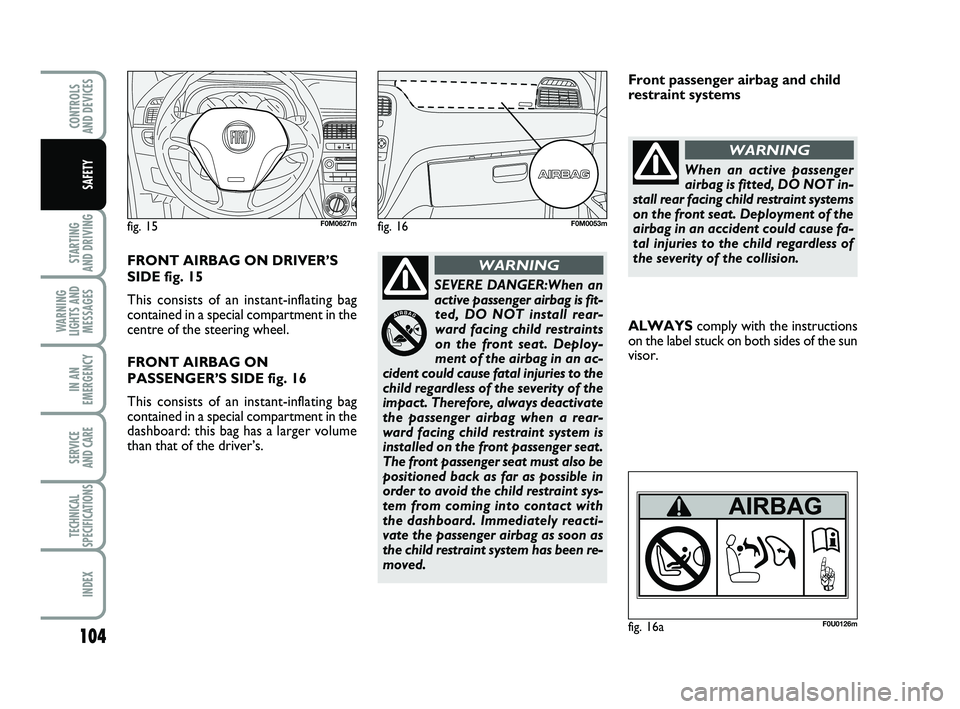
104
STARTING
AND DRIVING
WARNING
LIGHTS AND MESSAGES
IN AN
EMERGENCY
SERVICE
AND CARE
TECHNICAL
SPECIFICATIONS
INDEX
CONTROLS
AND DEVICES
SAFETY
SEVERE DANGER:When an
active passenger airbag is fit- ted, DO NOT install rear-
ward facing child restraints
on the front seat. Deploy-
ment of the airbag in an ac-
cident could cause fatal injuries to the
child regardless of the severity of the
impact. Therefore, always deactivate
the passenger airbag when a rear-
ward facing child restraint system is
installed on the front passenger seat.
The front passenger seat must also be
positioned back as far as possible in
order to avoid the child restraint sys-
tem from coming into contact with
the dashboard. Immediately reacti-
vate the passenger airbag as soon as
the child restraint system has been re-
moved.
WARNING
fig. 15F0M0627mfig. 16F0M0053m
FRONT AIRBAG ON DRIVER’S
SIDE fig. 15
This consists of an instant-inflating bag
contained in a special compartment in the
centre of the steering wheel.
FRONT AIRBAG ON
PASSENGER’S SIDE fig. 16
This consists of an instant-inflating bag
contained in a special compartment in the
dashboard: this bag has a larger volume
than that of the driver’s. ALWAYS
comply with the instructions
on the label stuck on both sides of the sun
visor. Front passenger airbag and child
restraint systems
When an active passenger
airbag is fitted, DO NOT in-
stall rear facing child restraint systems
on the front seat. Deployment of the
airbag in an accident could cause fa-
tal injuries to the child regardless of
the severity of the collision.
WARNING
fig. 16aF0U0126m
091-110 PUNTO POP 1ed EN 03/04/14 14:54 Pagina 104
Page 109 of 219
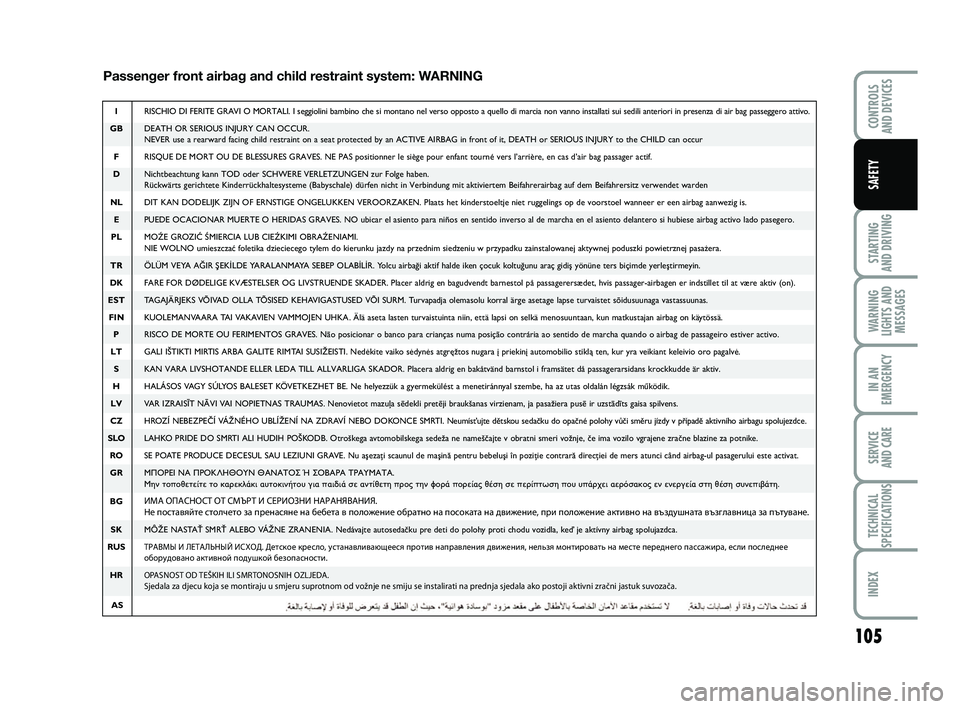
105
STARTING
AND DRIVING
WARNING
LIGHTS AND MESSAGES
IN AN
EMERGENCY
SERVICE
AND CARE
TECHNICAL
SPECIFICATIONS
INDEX
CONTROLS
AND DEVICES
SAFETY
Passenger front airbag and child restraint system: WARNING
I RISCHIO DI FERITE GRAVI O MORTALI. I seggiolini bambino che si montano n\
el verso opposto a quello di marcia non vanno installati sui sedili anteriori in presenza di air bag passeggero attivo.
GB DEATH OR SERIOUS INJURY CAN OCCUR.
NEVER use a rearward facing child restraint on a seat protected by an AC\
TIVE AIRBAG in front of it, DEATH or SERIOUS INJURY to the CHILD can occur
F RISQUE DE MORT OU DE BLESSURES GRAVES. NE PAS positionner le siège po\
ur enfant tourné vers l’arrière, en cas d’air bag passager actif.
D Nichtbeachtung kann TOD oder SCHWERE VERLETZUNGEN zur Folge haben.
Rückwärts gerichtete Kinderrückhaltesysteme (Babyschale) dü\
rfen nicht in Verbindung mit aktiviertem Beifahrerairbag auf dem Beifahrersitz verwendet warden
NL DIT KAN DODELIJK ZIJN OF ERNSTIGE ONGELUKKEN VEROORZAKEN. Plaats het kin\
derstoeltje niet ruggelings op de voorstoel wanneer er een airbag aanwezig is.
E PUEDE OCACIONAR MUERTE O HERIDAS GRAVES. NO ubicar el asiento para niñ\
os en sentido inverso al de marcha en el asiento delanter o si hubiese airbag activo lado pasegero.
PL MOŹE GROZIĆ ŚMIERCIA LUB CIEŹKIMI OBRAŹENIAMI.
NIE WOLNO umieszczać foletika dzieciecego tylem do kierunku jazdy na przednim siedzeniu w przypadku zainstalowanej aktywnej poduszki powietrznej pasażera.
TR ÖLÜM VEYA AĞIR \bEKİLDE YARALANMAYA SEBEP OLABİLİR. Yolcu airbaği aktif halde iken çocuk koltuğunu araç gidiş yönüne ters biçimde yerleştirmeyin.
DK FARE FOR DØDELIGE KVÆSTELSER OG LIVSTRUENDE SKADER. Placer aldrig \
en bagudvendt barnestol på passagerersædet, hvis passager-airbagen er indstillet til at være aktiv (on).
EST TAGAJÄRJEKS VÕIVAD OLLA TÕSISED KEHAVIGASTUSED VÕI SURM. Turvapadja olemasolu korral ärge asetage lapse turvaistet sõidusuunaga vastassuunas.
FIN KUOLEMANVAARA TAI VAKAVIEN VAMMOJEN UHKA. Älä aseta lasten turvaistuinta niin, että lapsi on selkä menosuuntaan, kun matkustajan airbag on käytössä.
P RISCO DE MORTE OU FERIMENTOS GRAVES. Não posicionar o banco para cria\
nças numa posição contrária ao sentido de marcha quando o airbag de passageiro estiver activo.
LT GALI IŠTIKTI MIRTIS ARBA GALITE RIMTAI SUSIŽEISTI. Ned\fkite vaiko s\fdyn\fs atgręžtos nugara į priekinį automobilio stiklą ten, kur yra veikiant keleivio oro pagalv\f.
S KAN VARA LIVSHOTANDE ELLER LEDA TILL ALLVARLIGA SKADOR. Placera aldrig e\
n bakåtvänd barnstol i framsätet då passagerarsidans krockkudde är aktiv.
H HALÁSOS VAGY SÚLYOS BALESET KÖVETKEZHET BE. Ne helyezzük a gyermekülést a menetiránnyal szembe, ha az utas oldalán légzsák műkö dik.
LV VAR IZRAISĪT NĀVI VAI NOPIETNAS TRAUMAS. Nenovietot mazuļa sēdekli pretēji braukšanas virzienam, ja pasažiera pusē ir uzstādī\ęts gaisa spilvens.
CZ HROZÍ NEBEZPEČÍ VÁŽNÉHO UBLÍŽENÍ NA ZDRAVÍ NEBO DOKONCE SMRTI. Neumísťujte dětskou sedačku do opačné polohy vůči směru jízdy v případě aktivního airbagu spolujezdce.
SLO LAHKO PRIDE DO SMRTI ALI HUDIH POŠKODB. Otroškega avtomobilskega sedeža ne nameščajte v obratni smeri vožnje, če ima vozilo vgrajene zračne blazine za potnike.
RO SE POATE PRODUCE DECESUL SAU LEZIUNI GRAVE. Nu aşezaţi scaunul de maşină pentru bebeluşi în poziţie contrară direcţiei de mers atunci când airbag-ul pasagerului este activat.
GR ΜΠΟΡEI ΝΑ ΠΡΟ\bΛΗΘΟ\fΝ ΘΑΝ\ΤΑΤΟΣ Ή ΣΟΒΑΡΑ ΤΡΑ\fΜΑΤΑ.\Τ
Μην τοποθετείτε το κα\Τρεκλάκι αυτοκινήτου γ\Τια παιδιά σε αντίθετη π\Τρος την φορά πορείας θέση\Τ σε περίπτωση που υπάρχε\Τι αερόσακος εν ενεργεία στη θέση συνεπ\Τιβάτη.
BG
ИМА ОПАС\bОСТ ОТ СМЪРТ И С\З\fРИОЗ\bИ \bАРА\bЯВА\bИЯ.
\bе поставяйте столче\Зто за пренасяне на бе\Збета в положение обра\Зтно на посоката на движе\Зние, при положение активн\Зо на въздушната възглавница за пътуване.
SK MÔŽE NASTAŤ SMRŤ ALEBO VÁŽNE ZRANENIA. Nedávajte autosedačku pre deti do polohy proti chodu vozidla, keď je aktívny airbag spol ujazdca.
RUS ТРАВМЫ И Л\fТАЛЬ\bЫЙ ИСХОД. Детс\Зкое кресло, устанавливаю\Зщееся против направле\Зния движения, нельзя монтир\Зовать на месте переднего\З пассажира, если последн\Зее
оборудовано активной по\Здушкой безопасности.
HR OPASNOST OD TEŠKIH ILI SMRTONOSNIH OZLJEDA.
Sjedala za djecu koja se montiraju u smjeru suprotnom od vožnje ne smiju se instalirati na prednja sjedala ako postoji aktivni zračni jastuk suvozača.
AS
091-110 PUNTO POP 1ed EN 02/04/14 10:12 Pagina 105
Page 110 of 219
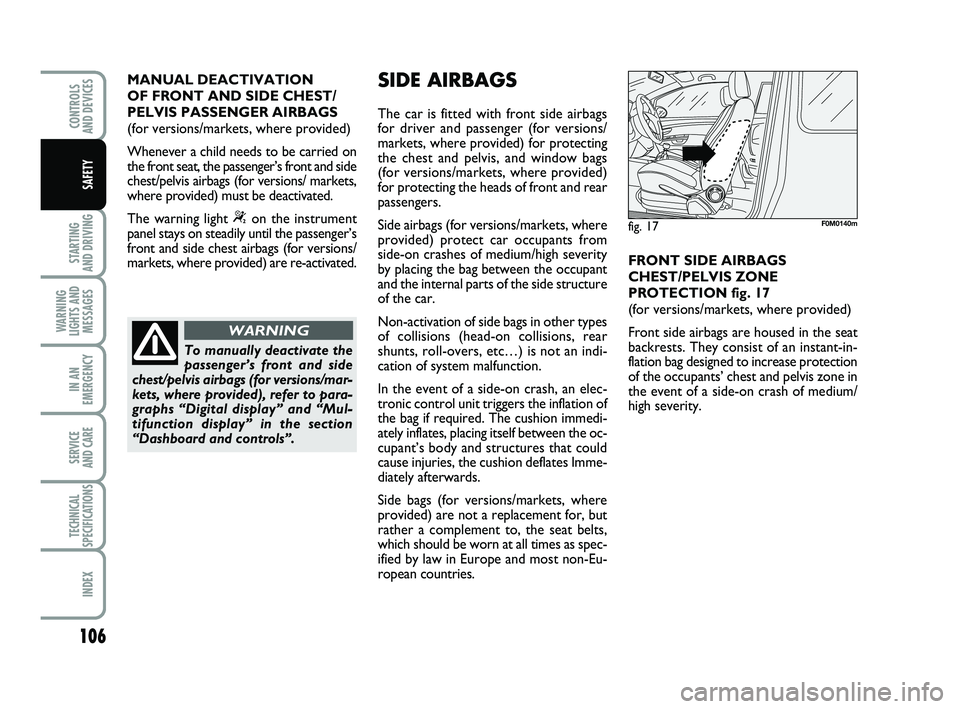
106
STARTING
AND DRIVING
WARNING
LIGHTS AND MESSAGES
IN AN
EMERGENCY
SERVICE
AND CARE
TECHNICAL
SPECIFICATIONS
INDEX
CONTROLS
AND DEVICES
SAFETY
MANUAL DEACTIVATION
OF FRONT AND SIDE CHEST/
PELVIS PASSENGER AIRBAGS
(for versions/markets, where provided)
Whenever a child needs to be carried on
the front seat, the passenger’s front and side
chest/pelvis airbags (for versions/ markets,
where provided) must be deactivated.
The warning light
“on the instrument
panel stays on steadily until the passenger’s
front and side chest airbags (for versions/
markets, where provided) are re-activated.
To manually deactivate the
passenger’s front and side
chest/pelvis airbags (for versions/mar -
kets, where provided), refer to para-
graphs “Digital display” and “Mul -
tifunction display” in the section
“Dashboard and controls”.
WARNING
SIDE AIRBAGS
The car is fitted with front side airbags
for driver and passenger (for versions/
mar kets, where provided) for protecting
the chest and pelvis, and window bags
(for versions/markets, where provided)
for protecting the heads of front and rear
passengers.
Side airbags (for versions/markets, where
provided) protect car occupants from
side-on crashes of medium/high severity
by placing the bag between the occupant
and the internal parts of the side structure
of the car.
Non-activation of side bags in other types
of collisions (head-on collisions, rear
shunts, roll-overs, etc…) is not an indi-
cation of system malfunction.
In the event of a side-on crash, an elec-
tronic control unit triggers the inflation of
the bag if required. The cushion immedi-
ately inflates, placing itself between the oc-
cupant’s body and structures that could
cause injuries, the cushion deflates Imme-
diately afterwards.
Side bags (for versions/markets, where
provided) are not a replacement for, but
rather a complement to, the seat belts,
which should be worn at all times as spec-
ified by law in Europe and most non-Eu-
ropean countries. FRONT SIDE AIRBAGS
CHEST/PELVIS ZONE
PROTECTION fig. 17
(for versions/markets, where provided)
Front side airbags are housed in the seat
backrests. They consist of an instant-in-
flation bag designed to increase protection
of the occupants’ chest and pelvis zone in
the event of a side-on crash of medium/
high severity.
fig. 17F0M0140m
091-110 PUNTO POP 1ed EN 27/03/14 12:02 Pagina 106